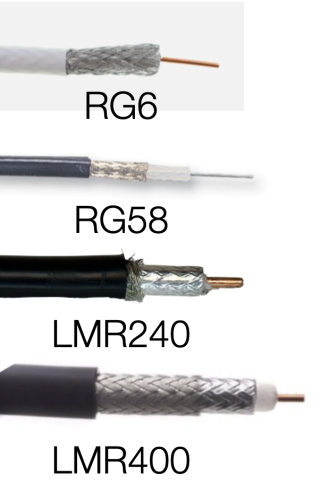
Coaxial cables are essential components of modern communication systems, providing a reliable means of transmitting signals over a variety of distances and applications. With different cable types available, each designed to suit specific needs, it’s important to understand the characteristics, advantages, and limitations of various coaxial cables. In this article, we will delve into a comparison of four popular coaxial cable types – two Radio Guide (RG) types, RG6 and RG58 – as well as two Land and Mobile Radio (LMR) types, LMR240 and LMR400.
RG6
General Specifications
- Impedance: 75 ohms
- Outer Diameter: Approximately 6.9 mm (0.272 inches)
- Average Signal Loss per 20ft: 2.3dB
- Recommended Max Cable Run: 50ft
Advantages
- Broadband Applications: RG6 is commonly used for cable television distribution and broadband internet connections due to its relatively high bandwidth capabilities.
- Signal Loss: With low signal loss at high frequencies, RG6 is suitable for longer cable runs without significant degradation of signal quality.
- Economical: RG6 cables are cost-effective and widely available, making them a popular choice for residential and commercial applications.
Limitations
- Flexibility: RG6 cables are thicker and less flexible compared to some other coaxial cables, making them less suitable for tight bends or installations in confined spaces.
- Impedance: RG6 cables typically have a higher impedance of 75 ohms, which limits their use in applications that require the more common 50 ohms impedance.
RG58
General Specifications
- Impedance: 50 ohms
- Outer Diameter: Approximately 5.0 mm (0.195 inches)
- Average Signal Loss per 20ft: 3.75dB
- Recommended Max Cable Run: 30ft
Advantages
- Flexibility: RG58 cables are thin, flexible, and easy to work with, making them suitable for applications that require tight bends or mobility.
- Versatility: RG58 cables are used in a range of applications including amateur radio, Ethernet, and military applications due to their moderate performance across different frequency ranges.
Limitations
- Signal Loss: RG58 cables exhibit higher signal loss at higher frequencies compared to other coaxial cables like RG6 and LMR types.
- Distance: Due to their higher loss characteristics, RG58 cables are better suited for shorter cable runs.
LMR240
General Specifications
- Impedance: 50 ohms
- Outer Diameter: Approximately 6.1 mm (0.240 inches)
- Average Signal Loss per 20ft: 1.9dB
- Recommended Max Cable Run: 30ft
Advantages
- Low Signal Loss: LMR240 cables offer lower signal loss compared to RG-type cables, making them suitable for longer cable runs and higher-frequency applications.
- Flexibility: While not as thin as RG58, LMR240 cables strike a balance between flexibility and signal performance.
Limitations
- Size: LMR240 cables are thicker than RG58, which may limit their use in applications where thin and lightweight cables are essential.
- Cost: LMR240 cables can be more expensive compared to some RG-type cables due to their enhanced performance characteristics.
LMR400
General Specifications
- Impedance: 50 ohms
- Outer Diameter: Approximately 10.29 mm (0.405 inches)
- Average Signal Loss per 20ft: 1dB
- Recommended Max Cable Run: 100ft
Advantages
- Low Signal Loss: LMR400 cables provide excellent signal transmission with very low loss, making them suitable for demanding applications and long cable runs.
Limitations
- Rigidity: LMR400 cables are relatively rigid compared to thinner coaxial cables, which might limit their use in installations requiring flexibility or tight bends.
- Cost: LMR400 cables are generally more expensive than many other coaxial cables due to their high performance.
Ultimately, the choice of coaxial cable depends on the specific requirements of the application. Keep in mind that these specifications are general guidelines, and the actual performance of a coaxial cable can be influenced by factors such as cable length, connectors, installation conditions, and manufacturing quality. Understanding the advantages and limitations of each coaxial cable type will help you make an informed decision based on the needs of your project.

